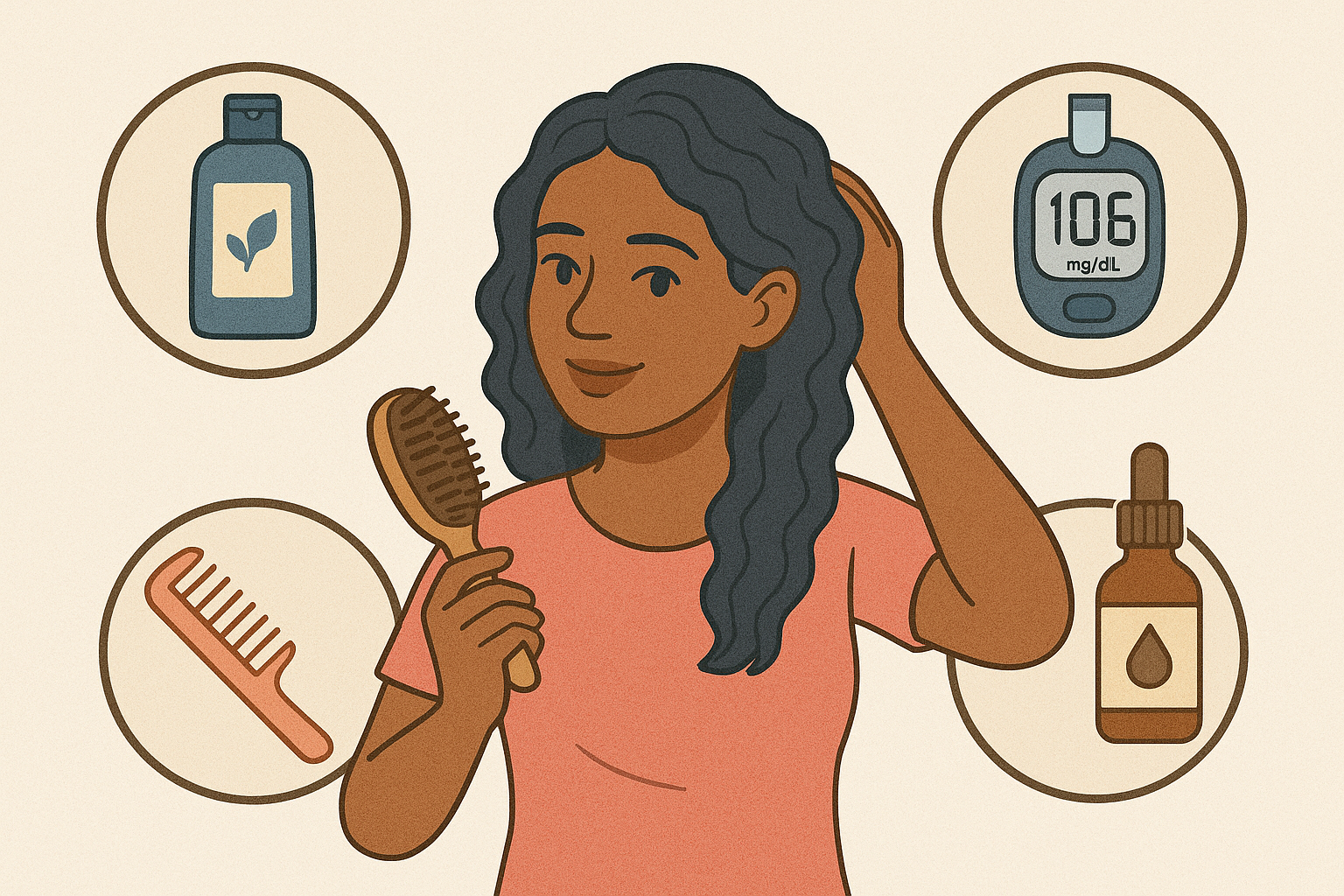Overview of Diabetes
Diabetes mellitus is a long term, chronic illness that alters how your body uses food as fuel. It happens when the body is unable to use the insulin it does make efficiently or does not produce enough of it. The pancreas secretes the hormone insulin, which facilitates the uptake of glucose (sugar) from food into your cells for energy production. Glucose accumulates in the circulation when there is insufficient insulin or when the body develops resistance to it. High blood sugar levels have the potential to cause major health issues over time, such as kidney damage, nerve damage, heart disease, and visual issues. Diabetes and hair loss are closely linked due to high blood sugar and poor circulation affecting hair health.
Types of Diabetes
The primary types include Type 1 diabetes, Type 2 diabetes, Gestational diabetes, and a few less common forms.

1. Type 1 Diabetes
Type 1 diabetes is an autoimmune condition. The immune system mistakenly attacks and destroys the insulin producing beta cells in the pancreas. As a result, the body produces little to no insulin.
- Onset: Commonly begins in childhood or adolescence but can occur at any age.
- Cause: Autoimmune response; exact cause unknown.
- Management: Daily insulin injections or use of an insulin pump, along with blood sugar monitoring and a balanced diet.
2. Type 2 Diabetes
Type 2 diabetes occurs when the body becomes resistant to insulin or when the pancreas fails to produce enough insulin.
- Onset: Typically develops in adults over the age of 45 but increasingly seen in younger people due to obesity and lifestyle factors.
- Cause: Insulin resistance often linked to genetics, obesity, and physical inactivity.
- Management: Lifestyle changes (diet, exercise), oral medications, and sometimes insulin.
3. Gestational Diabetes
Gestational diabetes develops during pregnancy in women who did not previously have diabetes. It affects how cells use glucose and typically disappears after childbirth.
- Onset: During the second or third trimester of pregnancy.
- Cause: Hormonal changes during pregnancy affect insulin function.
- Management: Diet, exercise, blood sugar monitoring, and sometimes insulin. It requires careful monitoring to protect both mother and baby.
4. Other Specific Types
These include less common forms of diabetes caused by genetic conditions, diseases of the pancreas, or as side effects of medications.
- MODY (Maturity-Onset Diabetes of the Young): A rare genetic form of diabetes that usually occurs before age 25.
- Neonatal Diabetes: A rare form that occurs in the first six months of life.
- Secondary Diabetes: Resulting from conditions like pancreatic disease or as a result of medications such as steroids.
Diabetes in Pakistan: Prevalence and Statistics
Pakistan has one of the highest diabetes prevalence rates globally. According to the International Diabetes Federation (IDF) Diabetes Atlas 2024, the key statistics for diabetes in Pakistan are as follows:
- Adult Population (20–79 years): Approximately 130.4 million
- Prevalence Rate: 31.4% of adults
- Total Cases: Around 34.5 million adults living with diabetes
These figures indicate that nearly one in three adults in Pakistan is affected by diabetes, highlighting a significant public health concern.
Challenges in Healthcare Access
Access to healthcare services for diabetes management in Pakistan is limited, especially in rural areas. Only about 35% of people with diabetes receive regular medical care, and many remain undiagnosed due to a lack of awareness and screening programs. Additionally, the cost of insulin and other essential medications is often prohibitive for low-income populations, leading to poor disease control and increased complications.
Global Diabetes Statistics
Global Prevalence:
As of 2024, approximately 11.1% of adults aged 20–79 years are living with diabetes worldwide. This indicates that more than 1 in 10 adults in this age group is affected by the condition.
Total Cases:
The total number of adults with diabetes globally is estimated to be 589 million in 2024.
Undiagnosed Cases:
About 43% of adults living with diabetes are unaware of their condition. This equates to over 250 million undiagnosed cases globally, highlighting the silent and often undetected nature of the disease.
Historical and Projected Growth:
The prevalence of diabetes has more than quadrupled since 1990. In that year, the global diabetic population was estimated at around 108 million. Today, the number of adults living with diabetes worldwide has surpassed 800 million, when considering all age groups and recent estimates from updated health surveillance models.
Why Diabetes Causes Hair Loss?
Diabetes, encompassing both type 1 and type 2, can contribute to hair loss through several interconnected mechanisms.

1. Poor Blood Circulation
Chronic high blood sugar levels can damage small blood vessels, leading to reduced blood flow. This diminished circulation can deprive hair follicles of essential nutrients and oxygen, impairing hair growth and leading to hair loss. Dr Malay Mehta+1BETTER+1
2. Hormonal Imbalances
Insulin resistance, a hallmark of type 2 diabetes, can disrupt hormonal balance, particularly increasing androgen levels. Elevated androgens can shrink hair follicles, shorten the hair growth phase, and result in hair thinning or loss. Liv Hospital – Future of Healthcare
3. Autoimmune Responses
Type 1 diabetes is an autoimmune condition, and individuals with it are at a higher risk of developing other autoimmune disorders, such as alopecia areata. In alopecia areata, the immune system attacks hair follicles, causing patchy hair loss on the scalp and other body areas. BETTERHealthline
4. Stress and Telogen Effluvium
Managing diabetes can be stressful, and physical or emotional stress can trigger telogen effluvium—a condition where hair prematurely enters the resting phase, leading to increased shedding.
5. Medication Side Effects
Some diabetes medications, such as metformin, can lead to nutrient deficiencies, notably vitamin B12. A deficiency in B12 can affect hair health, potentially leading to hair loss. honesthairrestoration
6. Peripheral Artery Disease (PAD)
Diabetes increases the risk of PAD, a condition where narrowed arteries reduce blood flow to the limbs. Reduced circulation can lead to hair loss on the legs and feet.
Symptoms of Hair Loss Due to Diabetes
Diabetes can influence hair health through various mechanisms, leading to distinct symptoms. Recognizing these signs is crucial for early intervention and effective management.
1. Diffuse Thinning of Scalp Hair
Individuals with diabetes may experience a general thinning of hair across the scalp. This occurs when high blood sugar levels disrupt the normal hair growth cycle, causing more hairs to enter the resting (telogen) phase prematurely, leading to increased shedding.
2. Patchy Hair Loss (Alopecia Areata)
Type 1 diabetes, an autoimmune condition, is associated with a higher risk of developing other autoimmune disorders like alopecia areata. This condition leads to sudden, patchy hair loss on the scalp and other body areas.
3. Slowed Hair Regrowth
After hair falls out, individuals with diabetes may notice that regrowth is slower than usual. This delay is often due to poor circulation and nutrient delivery to hair follicles, impairing their ability to regenerate hair efficiently.
4. Hair Loss on Limbs
Diabetes can lead to peripheral artery disease (PAD), reducing blood flow to extremities. This diminished circulation can cause hair loss on the legs and arms, serving as a warning sign of vascular complications. Align Foot & Ankle
5. Brittle and Fragile Hair
Elevated blood sugar levels can damage the protein structure of hair, making it brittle and more prone to breakage. This fragility contributes to an overall appearance of hair thinning and loss.
6. Scalp Infections
High glucose levels can create an environment conducive to fungal and bacterial infections on the scalp. These infections can damage hair follicles, leading to hair loss if not promptly treated.

Best Hair Care Tips for Diabetic Patients
Implementing targeted hair care strategies can help mitigate these effects.
1. Maintain Optimal Blood Sugar Levels
Consistently high blood glucose can damage small blood vessels, reducing blood flow to hair follicles and impairing hair growth. Effective diabetes management through diet, exercise, and medication adherence is crucial for hair health. Advanced Hair Restoration
2. Adopt Gentle Hair Care Practices
- Avoid Tight Hairstyles: Styles that pull tightly on the scalp, like tight ponytails or braids, can stress hair follicles and exacerbate hair loss.
- Limit Heat and Chemical Exposure: Frequent use of heat styling tools and chemical treatments can weaken hair strands. Opt for natural drying methods and minimize chemical processing. HealthMatch
- Use Mild Hair Products: Choose shampoos and conditioners that are free from harsh chemicals and sulfates to maintain scalp health.
3. Nutritional Support
A balanced diet rich in essential nutrients supports hair growth:
- Biotin (Vitamin B7): Found in eggs, nuts, and whole grains, biotin supports keratin production, essential for hair strength.
- Iron and Zinc: Deficiencies can lead to hair shedding; include lean meats, legumes, and leafy greens in your diet.
- Omega-3 Fatty Acids: Present in fatty fish and flaxseeds, they help maintain scalp health.
4. Regular Scalp Care
Maintaining a healthy scalp environment is vital:
- Scalp Massage: Regular massages can stimulate blood circulation, promoting nutrient delivery to hair follicles.
- Essential Oils: Oils like rosemary or lavender may support hair health; however, consult with a healthcare provider before use.
5. Consult Healthcare Professionals
If experiencing significant hair loss:
- Dermatologist Consultation: A specialist can assess the cause and recommend treatments such as topical minoxidil.
- Endocrinologist Review: Ensuring optimal diabetes management can indirectly improve hair health.
Final Thoughts
Living with diabetes doesn’t mean you have to accept hair loss. With these diabetic hair care tips, you can nourish your scalp, protect your hair, and regain confidence.
Taking care of your hair is part of taking care of yourself and small changes can lead to big improvements. Managing hair loss naturally is possible with a consistent routine that focuses on nutrition, gentle care, stress reduction, and lifestyle changes.

 Medically reviewed by
Medically reviewed by